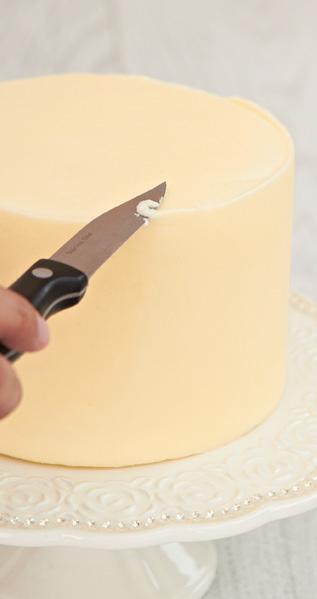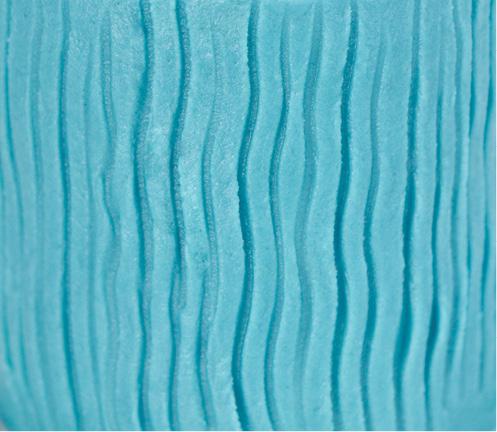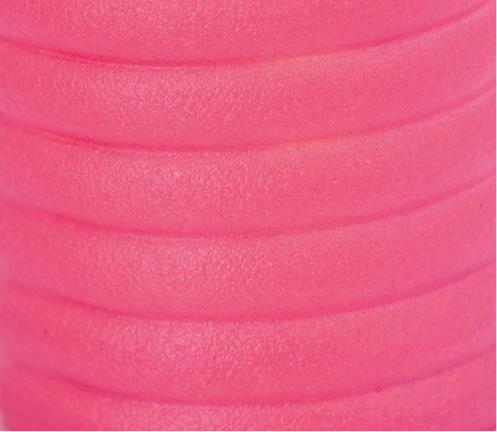Read The Contemporary Buttercream Bible Online
Authors: Christina Ong Valeri Valeriano
The Contemporary Buttercream Bible (6 page)

and it is very cheap. You can use any other similar
non-woven fabric as long as it is really smooth and
has no holes or ridges.
1 Make sure that you use either a palette knife or a
scraper to smooth and get rid of most of the lines or 60

ridges in the buttercream before the surface crusts.
This will be very helpful later during the actual
smoothing process.
2 Since our buttercream recipe is a ‘crusting’ type of frosting, it is important that you wait until the
surface is dry to the touch, usually 10–20 minutes.
Test this by gently touching the surface (A). If it still sticks on your finger, it means you have to let it
stand for few more minutes at room temperature.
Don’t chill it in the fridge as this is a moist
environment and will obviously not help in drying.
A
61

3 Using the smooth side of your non-woven cloth,
place it onto the surface of the cake and rub the
cloth using your fingers to flatten any ridges and
unevenness (B).
B
4 Slowly peel the cloth away and check if there are
still parts that need smoothing. Instead of rubbing
again, use a plain edge cake scraper gently and with
a little bit of pressure (C), running it over the cloth and all the away around the cake until perfectly
smooth (D).
62

C
63

D
Tip
When smoothing the side of the cake we
usually start from the bottom and work
upwards. We then scrape horizontally all
around the cake before smoothing from the
bottom up again until we get a perfectly
smooth finish.
64
Sharp Edges
A couple of wise men and women of the cake
decorating industry once told us that if you want to
create sharp edges on your cake, they must be
absolutely flawless. This can be a little tricky to
achieve in the beginning, but as we always say,
practice is the only secret.
It is very important to remove any excess
buttercream to achieve sharp edges, otherwise you
will find yourself in an endless repetitive loop:
smooth the side, excess goes to the top, smooth the
top, excess goes to the side
ad infinitum
!
1 Using a palette knife, scraper or a small kitchen
knife, trim the bumpy excess buttercream around
the edge of the cake. (A)
65

A
2 Apply the non-woven cloth on the surface and
smooth again with a help of a cake scraper (B).
66

B
Tip
Fresh buttercream gets exposed when you
trim the edges, so wait for it to crust again
before applying the non-woven cloth.
67
Before you decorate...
Let’s make it clear that the steps for covering
your cake with a smooth finish are as follows:
1. Crumb coat
2. Apply a layer of buttercream and level/
smooth with a palette knife
3. Smooth with a cake scraper
4. Smooth further with non-woven cloth
5. Create sharp edges
Important!
In the chapters that follow we have created at least one couture cake to
demonstrate the technique we have shown in
that chapter. It is assumed in the instruction for
creating the cake that you have already crumb
coated it. Note that you will need about
200–300g (7–101⁄2oz) of plain buttercream to
crumb coat each cake. This quantity is not
included in the requirements list for the cake.
68

Textured Finish
Rather than making the surface perfectly smooth,
here is another way of covering your cake. The
results can be achieved in a flash just by using some simple tools.
Fork
Simply run the fork over the surface of your cake in
whichever direction you wish. You can even do a
wavy motion.
69

Palette knife
By using a simple palette knife, you can give
another textured finish on your cake. Different
stokes will result in various lovely effects.
Cake comb
Cake combs are another fantastic tool for creating
texture. They are made of either thin plastic or
metal and have different contoured edges – waves,
ridges and swirls. You just run the edge of the
scraper around your cake to form ridges. To get the
best result, comb your cake when the buttercream is
freshly applied and use a cake turntable.
70

Impression mats
Impression mats (also called texture mats) are
plastic or silicone sheets with fantastic designs that will allow you to emboss prints directly into the
surface of your cake. They are mostly used for
sugarpaste
(rolled
fondant)
but
since
our
buttercream recipe is a ‘crusting’ type, you will be
able to use these sheets. Just make sure that surface of the cake has already crusted properly by touching
